Welcome to the Noise Office for PHL and PNE
Philadelphia International Airport (PHL) and Northeast Philadelphia Airport (PNE) bring important economic and connectivity benefits to the Philadelphia region, yet we recognize that aircraft traveling to and from our airports also create environmental challenges such as noise. The Noise Office, a branch of the City of Philadelphia’s Department of Aviation, is committed to monitoring noise and working with our neighbors, the Federal Aviation Administration (FAA) and aircraft operators to minimize noise impacts.
Efforts to study aircraft noise at PHL date back to 1975. Studies show that noise impacts from aircraft arriving and departing PHL have steadily decreased from 1980 to the present, despite the increase in air traffic to and from Philadelphia. View noise contour comparison, 1980-2018
The Noise Office tracks all aircraft operations at PHL and PNE, monitoring arrival and departure times, flight paths, aircraft types, runways used, and atypical flight operations. The Noise Office responds to noise-related complaints concerning aircraft operations at PHL and PNE; advocates for compatible land uses surrounding the airport; and has provided sound insulation to over 400 homes within the noise impact area surrounding PHL.
The Noise Office established a Fly Quiet program in 2012 to minimize noise due to aircraft operations and maintenance. The Fly Quiet Program educates pilots on noise-sensitive areas and flight routes that can reduce noise for residential communities.
PHL Flight Tracker
The Federal Aviation Administration (FAA) directs air traffic at Philadelphia International Airport (PHL). The traffic flow in use at PHL at any given time is dictated primarily by the wind direction. With very few exceptions, aircraft land, and takeoff into the prevailing wind. A headwind increases the airflow over the wings, producing more lift. The increased lift generated from the headwind reduces the amount of runway required to takeoff. The same headwind reduces the aircraft’s ground speed allowing it to land at a lower speed and use less runway to stop.
The directions at which airplanes arrive and depart PHL are referred to as “East Flow” and “West Flow”. The majority of the time, wind at PHL blows from south-southwest to north-northwest. As such, approximately 70 percent of the flight operations during a given year at PHL take place when the airport is in “West Flow.”
The graphics below illustrate the typical flight patterns for aircraft arriving/departing PHL. Deviations from these standard flight procedures sometimes occur due to weather, aircraft spacing requirements, and other circumstances.
The first aircraft noise standards were promulgated in 1969 (Title 14, Part 36 of the Code of Federal Regulations) establishing noise thresholds for newly manufactured aircraft. Three public laws – the Noise Control Act of 1972, the Aviation Safety and Noise Abatement Act of 1979, and the Airport Noise and Capacity Act of 1990 – enacted standards and guidance to help reduce non-compatible land use around airports, specifically residential development, in areas with significant aircraft noise as defined by the Federal Aviation Administration (FAA).
Day-Night Levels (DNLs) were identified by the FAA, the U.S. Environmental Protection Agency, and the Department of Housing and Urban Development as the metric for evaluating aircraft noise. A DNL is a 24-hour average sound level derived by adding a 10-decibel penalty to each aircraft noise event during nighttime hours (10:00 pm to 7:00 am). Noise-sensitive land uses such as residences, schools, hospitals, or places of worship that are exposed to DNLs of 65 decibels or more may be eligible for federally funded sound insulation.
For more information on current and historic aircraft noise standards and to learn how airports prepare noise studies, see: Federal Aviation Administration.
The Noise Office developed the Fly Quiet program in 2012 to reduce PHL’s aircraft noise footprint on airport neighbors. The measures that comprise the Fly Quiet Program were evaluated in two studies that specifically focused on aircraft noise, as well as Environmental Assessments and Environmental Impact Statements that have been prepared to evaluate improvements to PHL.
Fly Quiet policies are as follows:
Daytime (6 am to 11 pm)
Engine run-ups after significant aircraft maintenance require prior approval and should not exceed more than 20 minutes. The preferred location for the run-ups is Taxiway K at H with the airplane facing east but may also be conducted at Taxiway P at Taxiway W facing west.
Nighttime (10 pm to 6 am)
Excluding specific aircraft and when conditions are conducive to do so (e.g., weather conditions are favorable):
East Flow Departures from Runways 9L and 9R: The Federal Aviation Administration (FAA) will direct aircraft to fly a heading of 110 degrees and aircraft will not initiate turns if they are within six miles of PHL unless the altitude of the aircraft is greater than 2,000 feet above mean sea level.
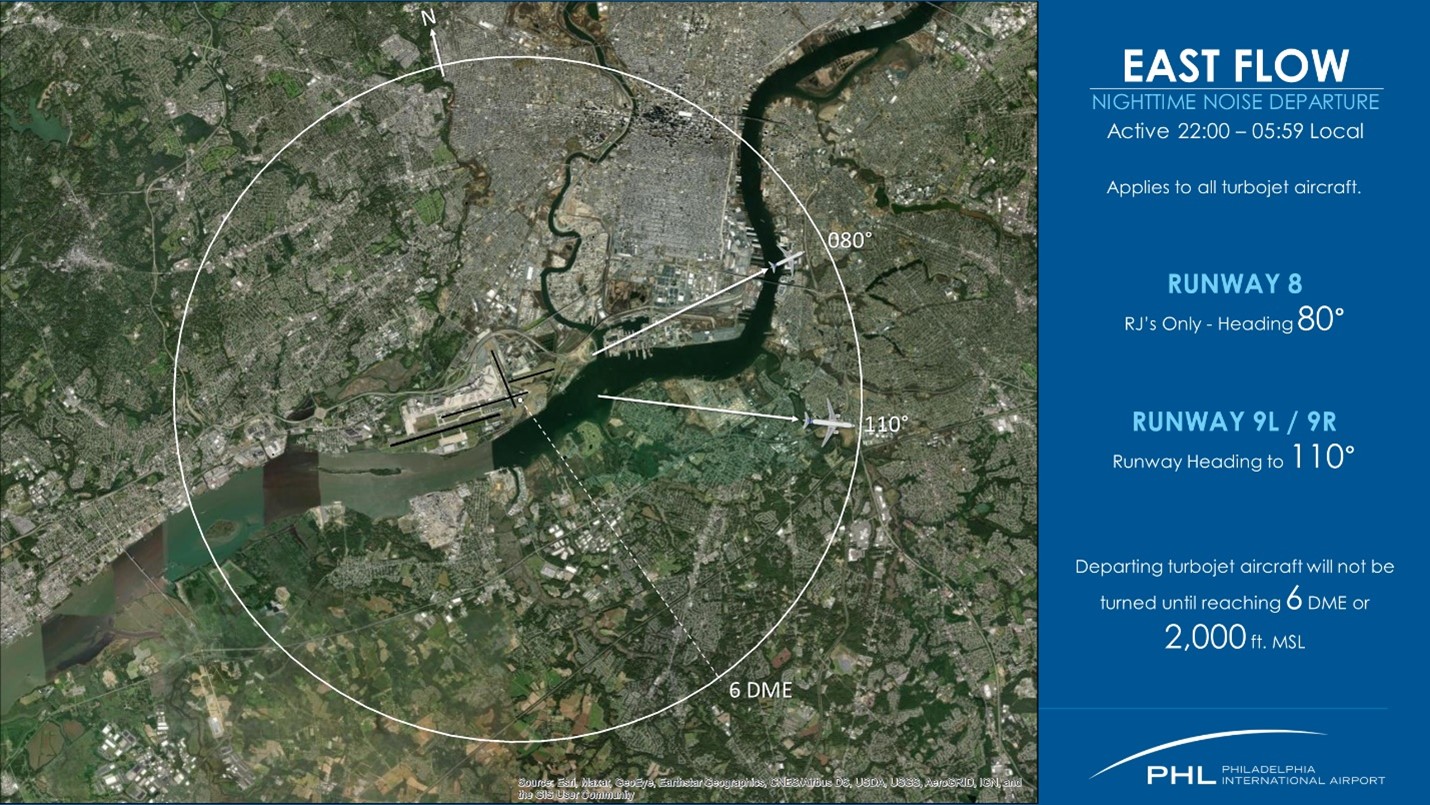
West Flow Departures from Runways 27L and 27R: The FAA will direct aircraft to fly a heading of 245 degrees and aircraft will not initiate turns if they are within six miles of PHL unless the altitude of the aircraft is greater than 3,000 feet above mean sea level.
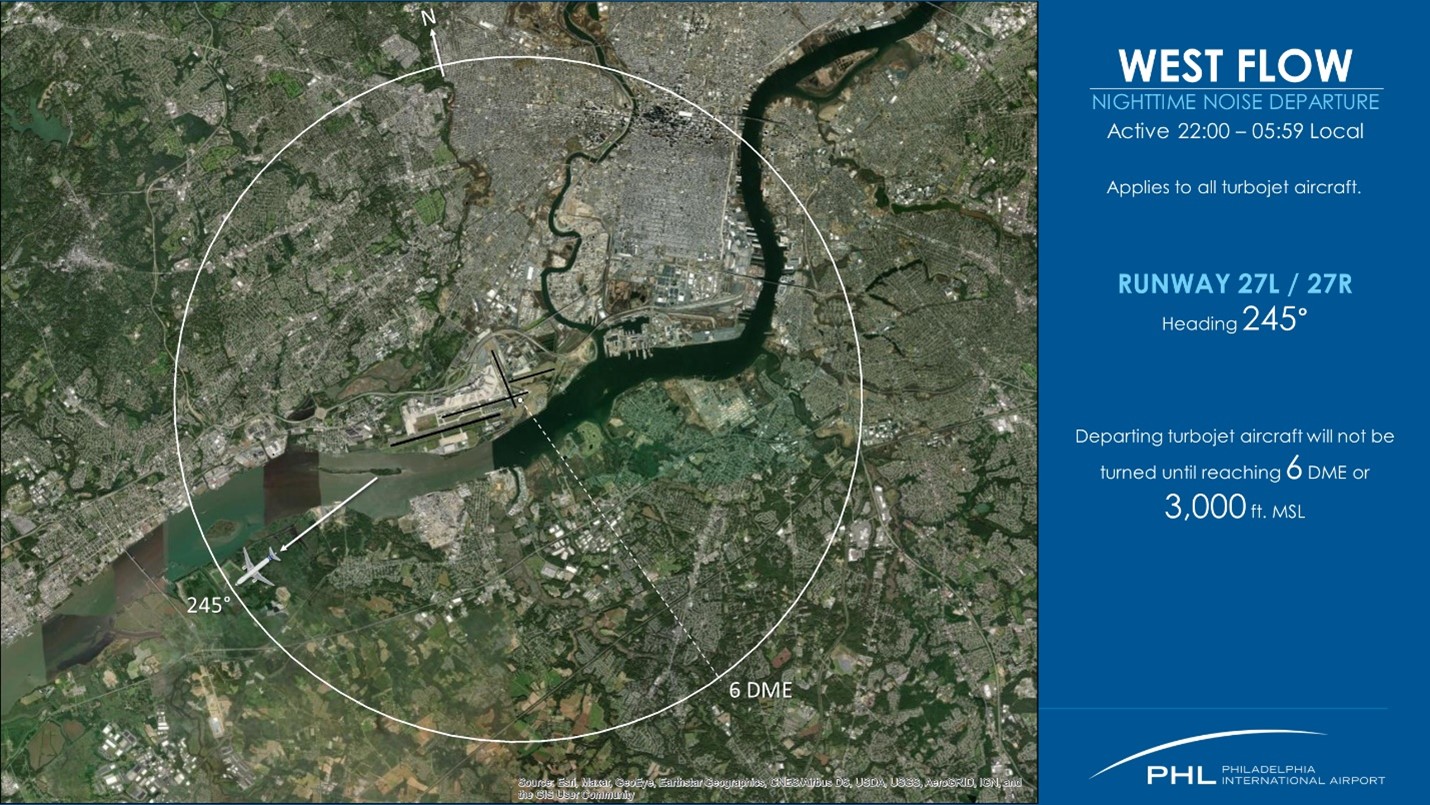
Nighttime (11 pm to 6 am)
Engine run-ups after significant aircraft maintenance require prior approval and should not exceed more than 20 minutes. Run-ups are to be performed at Taxiway K at Taxiway H with the plane facing east. Or alternatively at Taxiway P at Taxiway W with the plane facing west.
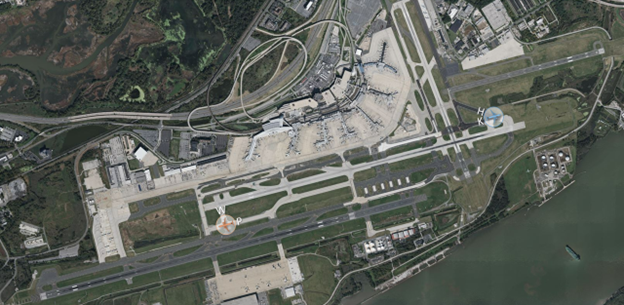
Nighttime (Midnight to 6 am)
The FAA will, to the extent feasible and reasonable to do so, use a preferential runway system:
East Flow – Aircraft will depart on Runways 9L and 9R and land on Runway 9R.
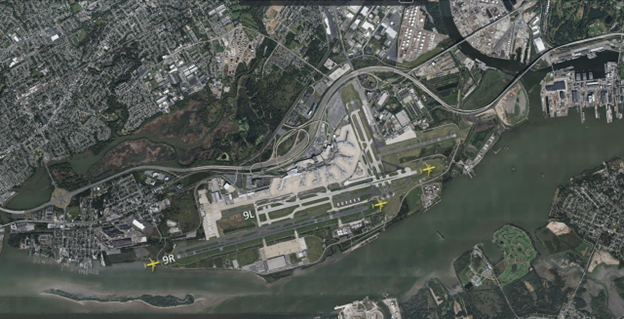
West Flow – Aircraft will depart on Runway 27L and arrive on Runway 27L and 27R.
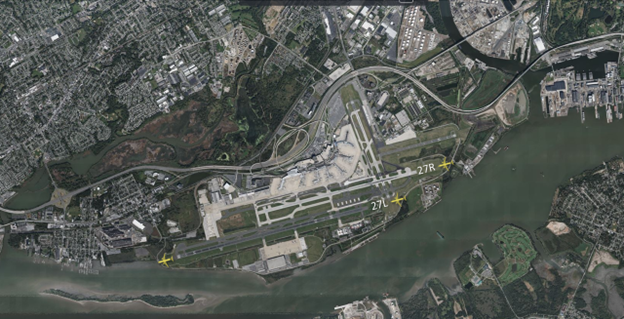
Aircraft noise contours are lines on an aerial photograph or map depicting equal levels of aircraft noise. Noise contours are produced using aircraft performance data and airport-specific data such as the layout of the runways; the daily average number of arrivals and departures; aircraft fleet; direction of aircraft flow; arrival and departure flight paths; time of day and meteorological data.
Noise contours indicate the average annual Day-Night Levels (DNL) of aircraft noise, not single event noise. Noise-sensitive land uses such as residences, schools, and hospitals that are located within the 65-decibel contours may be eligible for sound insulation through the Federal Aviation Administration (FAA) federally funded noise mitigation program.
The Noise Office prepares noise contours for internal planning reasons and voluntary studies that are prepared in compliance with Title 14, Part 150 of the Code of Federal Regulations (Airport Noise Compatibility Planning) or as required for proposed projects (per the National Environmental Policy Act).
The noise contour below was developed using the FAA’s Aviation Environmental Design Tool (AEDT) and represents the noise impact of PHL aircraft operations in 2018, before the decline in air traffic during 2020 and 2021 due to the COVID-19 pandemic. The City of Philadelphia Department of Aviation (DOA) projects that air traffic will continue to grow in future years and surpass pre-pandemic levels.
2018 PHL Airport Noise Contours
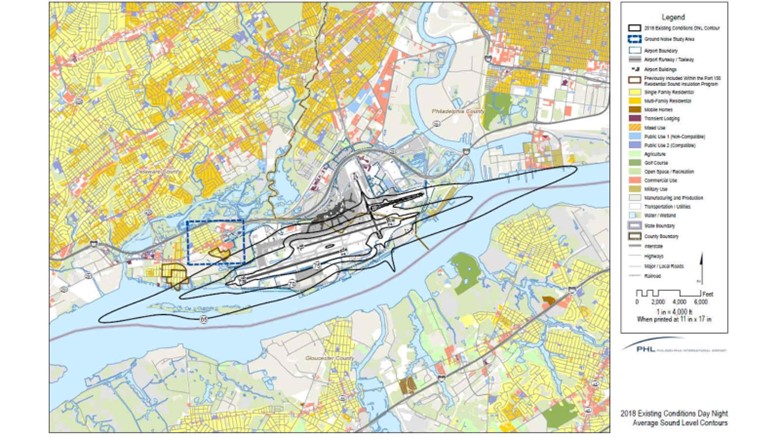
Download the 2018 Noise Contour HERE
Beginning in the late 1990s, the Noise Office has prepared voluntary noise studies (in accordance with Title 14, Part 150 of the Code of Federal Regulations, Airport Noise Compatibility Planning) to identify communities impacted by airport noise and reduce those impacts. The documents for the first study were published in 2001 (Year 2001 and 2006 Noise Exposure Maps) and in 2002 the Initial Noise Compatibility Plan. In 2009, the Noise Office updated the Noise Exposure Maps to reflect existing and forecast conditions at that time (Year 2008 and 2013 Noise Exposure Maps). Efforts to further reduce airport noise impacts are described in a document published in 2012 Noise Compatibility Plan Update.
These studies were voluntarily performed to develop a balanced and cost-effective plan for reducing the noise impacts that were occurring at the time of the studies and to limit impacts that were predicted to occur in the future. The initial 2002 study identified homes in Tinicum Township that were located inside the Day-Night Level (DNL) 65 or greater decibel contours that had the potential to qualify for federally funded sound insulation.
The Noise Office performed a pilot program to evaluate the effectiveness of the sound insulation and then completed sound insulation in 445 eligible residences in Tinicum by 2012, utilizing grant funds from the Federal Aviation Administration (FAA).
As airport operations grow in response to increased passenger traffic, PHL will continue to engage in new noise studies to quantify the potential effects on surrounding communities and use those noise contours to direct future sound insulation and airport planning initiatives.
Over time, numerous studies and documents have been prepared that address the effects of aircraft operations at Philadelphia International Airport (PHL). The Noise Office will continue to add future noise studies and plans at this location. The most recent noise-related studies:
- 2001-2006 Noise Exposure Maps
- 2002 Initial Noise Compatibility Plan
- 2005 Environmental Impact Statement for Extension of Runway 17-35
- 2010 Noise Exposure Map Update
- 2012 Noise Compatibility Plan Update
- Summary
- 2021 Environmental Assessment for West Cargo Redevelopment and Expansion Plan
Northeast Philadelphia Airport (PNE) has primary runways that are oriented east-west and north-south. Aircraft arrive and depart the airport in “East Flow”; “West Flow”; “North Flow” and “South Flow”. Not considering periods when one of the two runways at PNE are closed for maintenance/rehabilitation, most of the operations at the airport take place when the airport is in “West” Flow.
PNE’s traffic flows are dictated by the winds, but during calm wind conditions the flow is also influenced by Philadelphia International Airport's (PHL’s) current flow direction to minimize traffic conflicts between the two airports. The runways may be used in one flow direction for extended periods of time if prevailing winds are from that direction.
You can access the City of Philadelphia’s Flight Tracker at: https://webtrak.emsbk.com/phl1
In addition to private owners of aircraft using PNE, two activities at the airport result in additional aircraft-related noise—pilot flight training and helicopter manufacturing. To reduce the effect of these activities on airport neighbors, the Federal Aviation Administration (FAA) has implemented the following procedures:
Procedure Implementation
- Operators of turbo-jet powered airplanes with a maximum certified takeoff weight over 12,500 pounds should follow the standard noise abatement profiles unless authorized or directed by Air Traffic Control.
- Pilots of turboprop, turbojet, and large prop aircraft (prop aircraft of more than 12,500 pounds) are requested to use Runway 6-24, unless significant winds direct otherwise.
Departure Procedures
- All departures shall maintain runway heading until reaching 400 feet above ground level before making any turns.
- Runway 33 Visual Flight Rules (VFR) departures, in addition to the above, are requested to begin the cross-wind leg at or prior to the first highway northwest of the airport.
Arrival Procedures
- Runway 15 arrivals are requested to fly at or above the standard glide path to avoid a noise-sensitive area off the approach end of the runway.
Runway Usage
- Runway usage as directed by Air Traffic Control. Unless otherwise required by distance from clouds criteria, the traffic pattern altitudes for PNE are as follows:
- Lightweight aircraft (less than 12,500 pounds): 1000 feet above ground level.
- Aircraft weighing 12,500 pounds or more and all turbojet/turbine powered aircraft: 1,500 feet above ground level.
- Rotorcraft (e.g., helicopters): 800 feet above ground level and avoid residential area on the east-southeast boundary of the airport.
- As directed by Air Traffic Control, touch and go aircraft are to make a right-hand traffic pattern when utilizing Runway 6.
Engine Runups
Engine run-ups shall be limited to the following locations:
- Between the hours of 0600-2300 (6am and 11pm):
- Lightweight aircraft (less than 12,500 pounds) are to run up on the concrete ramp, which is that portion of the main ramp northwest of taxiway Alpha-4.
- Aircraft over 12,500 pounds are to run up on taxiway Hotel between Runway 6-24 and taxiway Alpha, as directed by the Air Traffic Control.
- Between the hours of 2300-0600 (11pm and 6am):
- Aircraft engine run-ups must have prior approval from the airport staff.
- Runups of all aircraft are to be performed on taxiway Lima.
- When winds are from the west, northwest, northeast, or east, run-ups are to be performed near the approach end of Runway 24.
- When winds are from the southeast, south, or southwest, run-ups are to be performed between Runway 15-33 and taxiway Juliet.
Touch-and-Go Operations
This is strictly a voluntary program. Using the FAA’s Automatic Terminal Information Service (ATIS), pilots are informed to limit touch-and-goes to the following days/hours and number of revolutions:
- Mondays through Saturdays between the hours of 09:00 (9 am) and 22:00 (10 pm).
- Sundays between the hours of 12:00 (noon) and 22:00 (10 pm).
- Limit the number of touch-and-goes to five per flight.
Hold Pad Delays
During extended delays on hold pads, it is suggested that pilots restrict unnecessary use of engines to reduce noise.
To learn more about the PNE Runway 15-33 closure for pavement rehabilitation, click here.
Use this link to file a complaint about aircraft noise surrounding Philadelphia International Airport (PHL) or submit a complaint via the Airport Noise Hotline at (215) 937-6750.
The Noise Office investigates complaints using radar and flight data. If a complaint is caused by an irregular operation, such as an aircraft deviating from a usual procedure, the Noise Office works with Air Traffic Control to determine the cause and reduce future occurrences. The Noise Office will typically respond in five business days or less. Your patience is appreciated.
If your concern is about an aircraft you believe to be operating unsafely, please note that the FAA is the responsible agency for aviation safety. You can locate the appropriate Flight Standards District Office (FSDO) here: http://www.faa.gov/about/office_org/field_offices/fsdo/
How can I file a noise complaint?
Contact the Department of Aviation's Noise Office by phone: 215-937-6750 or email: [email protected]. Please provide your name, phone number, the address at which the complaint is relevant, the time of day relevant to the complaint, and any other information that would assist us in responding. For more information, see File a Noise Complaint here.
Will filing a noise complaint change how the Federal Aviation Administration (FAA) operates Philadelphia International Airport (PHL) or Northeast Philadelphia Airport (PNE)?
Complaints filed with the Noise Office provide a means to report and disseminate the information in the noise complaint to the Federal Aviation Administration (FAA), airlines, public, and local representatives, all of which can contribute to potential operational changes at PHL and PNE. However, the FAA has the sole authority over how an airport operates, and they along with the pilot flying the aircraft have the authority to determine where aircraft fly.
Who directs pilots where and when to turn an aircraft?
The FAA controls and regulates all navigable airspace. Any change in departure or arrival flight paths must be approved and implemented by the FAA. For any given flight, where and when to turn an aircraft is the responsibility of the FAA and the pilot operating an aircraft. The Noise Office has no authority over the aircraft operating at PHL or PNE but provides policies and encourages pilots to minimize noise impact on surrounding communities.
How is the flow of aircraft decided?
See How Aircraft Flow is Directed
How does weather change when and where aircraft fly?
Storms, heavy winds and low visibility can lead to significant disruptions in the air traffic to/from PHL and affect activity at PNE. When an aircraft is preparing to takeoff, the FAA may direct the pilot to hold on the ground until a storm passes. Significant meteorological conditions that aren’t occurring at the airport but are moving toward the airport can change the flight path that FAA directs pilots to utilize when arriving or departing either airport.
How does weather change aircraft noise levels?
Several weather-related factors can affect the level and frequency of noise at a given location from day-to-day. As described in the How Aircraft Flow section, the direction from which the wind is blowing will change a listener’s exposure to aircraft-related noise by changing the direction of departures and arrivals to the airport. Cloud cover and temperature can also change noise levels. Cloud covers bend (rebound) sound waves downward toward a listener. Similarly, when there is a temperature inversion (for instance, temperatures that increase with an increase in height), sound waves are refracted downward. Because aircraft engines and wings are more efficient at low temperatures, on cold days airplanes taking off will use less runway to get airborne allowing them to pass over a given location at a higher altitude than would occur on a warmer day.
Can the airline operating a loud aircraft be fined?
Title 14, Part 161 of the Code of Federal Regulations (14 CFR 161) addresses the requirements for fining an airline operating a loud aircraft. To do so, the following six statutory conditions must be met:
- The fine must be reasonable, nonarbitrary, and nondiscriminatory.
- The fine must not create an undue burden on interstate or foreign commerce.
- The fine must be consistent with maintaining the safe and efficient use of the navigable airspace.
- The fine cannot conflict with a United States law or regulation.
- There must be adequate opportunity for public comment on the intent to fine the airlines.
- The fine must not create an undue burden on the national aviation system.
Why can’t the Noise Office institute a nighttime curfew on aircraft operations at PHL?
Title 14, Part 161 of the Code of Federal Regulations (14 CFR 161) addresses the requirements for instituting a nighttime curfew on aircraft operations. To do so, the following six statutory conditions must be met:
- The curfew must be reasonable, nonarbitrary, and nondiscriminatory.
- The curfew must not create an undue burden on interstate or foreign commerce.
- The curfew must be consistent with maintaining the safe and efficient use of the navigable airspace.
- The curfew cannot conflict with a United States law or regulation.
- There must be adequate opportunity for public comment on the curfew.
- The curfew must not create an undue burden on the national aviation system.
Why do aircraft fly over my house?
On any given day, one or more aircraft may fly over a residence that is in the vicinity of PHL or PNE as well as areas far removed from either airport. Aircraft may be arriving or departing the airports or be traversing the airspace to/from other airports in the United States or, in the case of PHL, to/from airports in other countries. The current aircraft arrival and departure paths were established by the FAA to provide the safest and most efficient system for aircraft using the airports. PHL’s typical flow and typical arrival and departure paths are described/illustrated on How Aircraft Flow is Directed. PNE’s typical flow and usual arrival and departure paths are described/illustrated on Northeast Philadelphia Airport (PNE) Aircraft Noise (link to page).



